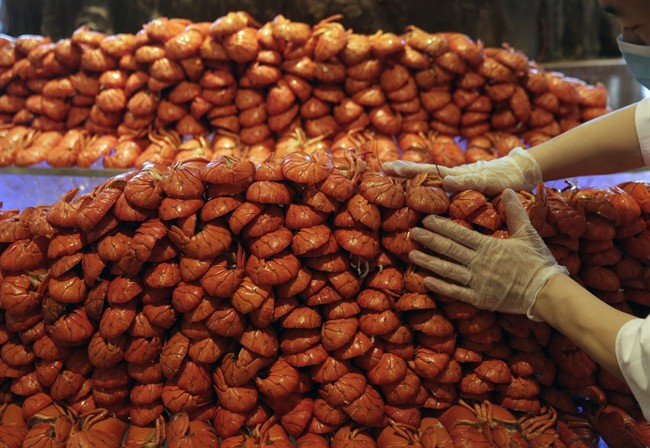It is important that a lobster is alive before you cook it. Any lobster with sluggish movement should be used immediately. Lobsters that are totally limp (dead) should be discarded.

In their natural state, Canadian lobsters are generally greenish-blue to brownish-olive. But they all cook up red.
Under ideal frozen temperatures of -26 to -30 C (-15 to -22 F) or below, frozen lobster can be stored with no quality loss for up to nine months.
READ MORE: Recipes for lobster with salad, in chowder, pasta and on a sandwich
Boiling lobster is probably the most popular method of preparation, but it can also be steamed, poached, baked, broiled and grilled. Detailed instructions are available online.
Live lobster will keep 36 to 40 hours out of water if they are kept in a cool damp environment (refrigerator) and their gills are kept moist. Ensure they are not exposed to freshwater ice or melt-water. They should be placed in open containers and kept moist with dampened newspapers or towels.
The bands placed around the claws should be left in place until a lobster is cooked.
Cooked lobster can be stored in airtight containers in the refrigerator for up to three days or up to four if the meat is removed from the shell. Cooked lobster meat can be frozen.
READ MORE: Forget fancy restaurants – lobster best enjoyed at your picnic table
The green substance on lobster, called the tomalley, is the liver. There may also be a red substance known as the roe (eggs) found in some female lobsters. The white foamy substance often encountered is the lobsters’ fat and blood. All are edible and considered delicacies by some, but they can be scraped off.
Nutritionally, hard-shell lobster has fewer than 100 calories per 100-gram serving, with 89 per cent of calories from protein. It is low in fat and carbohydrates, has virtually no saturated fats and is a good source of vitamins and minerals.
The Atlantic lobster does not feel pain when it is immersed into hot water due to its decentralized nervous system. The sound heard when boiling lobster is steam escaping from the shell.
It takes a lobster six to eight years to reach a market weight of about 500 g (1 lb).
Source: Lobster Council of Canada.

Comments